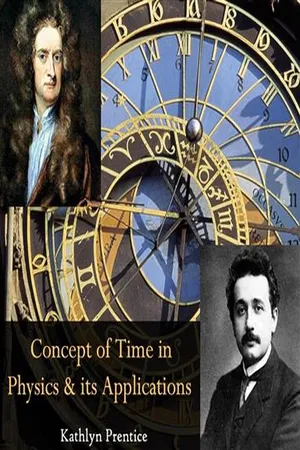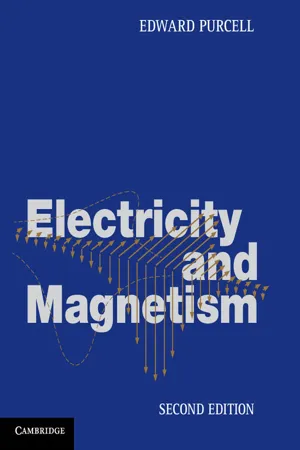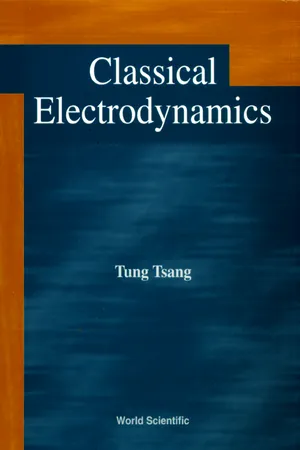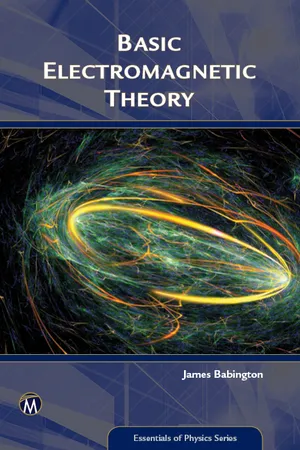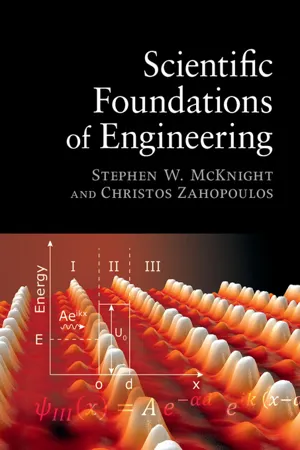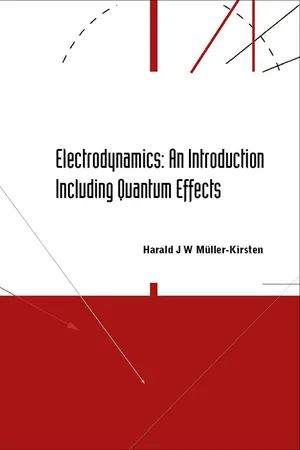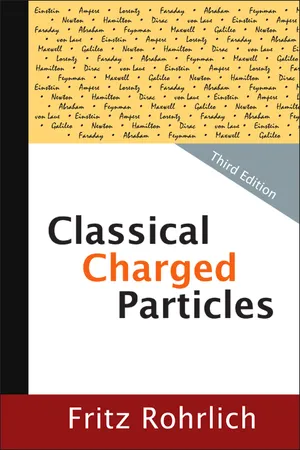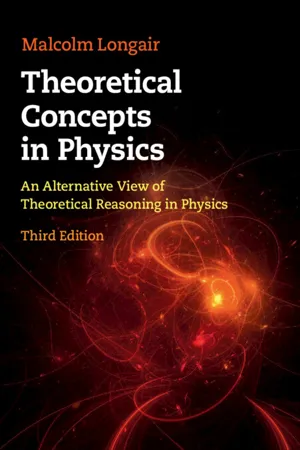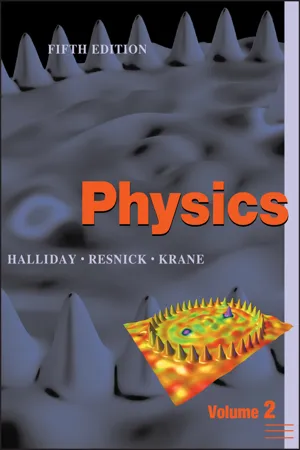Physics
4th Maxwell Equation
The 4th Maxwell Equation, also known as Gauss's law for magnetism, states that the magnetic field lines are continuous, with no beginning or end, and that there are no magnetic monopoles (isolated magnetic charges). This equation helps to describe the behavior of magnetic fields and their relationship to electric currents and charges.
Written by Perlego with AI-assistance
Related key terms
1 of 5
11 Key excerpts on "4th Maxwell Equation"
- No longer available |Learn more
- (Author)
- 2014(Publication Date)
- Learning Press(Publisher)
However, the potentials can be introduced by algebraic manipulation of the four fundamental equations. On Physical Lines of Force The four modern day Maxwell's equations appeared throughout Maxwell's 1861 paper On Physical Lines of Force : 1. Equation (56) in Maxwell's 1861 paper is ∇ ⋅ B = 0. 2. Equation (112) is Ampère's circuital law with Maxwell's displacement current added. It is the addition of displacement current that is the most significant aspect of Maxwell's work in electromagnetism, as it enabled him to later derive the electromagnetic wave equation in his 1865 paper A Dynamical Theory of the Electromagnetic Field, and hence show that light is an electromagnetic wave. It is therefore this aspect of Maxwell's work which gives the equations their full significance. (Interestingly, Kirchhoff derived the telegrapher's equations in 1857 without using displacement current. But he did use Poisson's equation and the equation of continuity which are the mathematical ingredients of the displacement current. Nevertheless, Kirchhoff believed his equations to be applicable only ________________________ WORLD TECHNOLOGIES ________________________ inside an electric wire and so he is not credited with having discovered that light is an electromagnetic wave). 3. Equation (115) is Gauss's law. 4. Equation (54) is an equation that Oliver Heaviside referred to as 'Faraday's law'. This equation caters for the time varying aspect of electromagnetic induction, but not for the motionally induced aspect, whereas Faraday's original flux law caters for both aspects. Maxwell deals with the motionally dependent aspect of electro-magnetic induction, v × B , at equation (77). - eBook - PDF
- Edward Purcell(Author)
- 2011(Publication Date)
- Cambridge University Press(Publisher)
The electrical consti- tution of matter was a mystery, the relation between light and elec- tromagnetism unsuspected. Many of the arguments that we have used to make our next step seem obvious were unthinkable then. Neverthe- less, as Maxwell's theory developed, the term we have been discussing, aE/at, appeared quite naturally in his formulation. He called it the displacement current. Maxwell was concerned with fields in solid matter as well as in vacuum, and when he talks about a displace- ment current he is often including some charge-in-motion, too. We'll clarify that point in Chapter 10 when we study electric fields in mat- ter. Indeed, Maxwell thought of space itself as a medium, the "aether," so that even in the absence of solid matter the displacement current was occurring in something. But never mind-his mathemat- ical equations were perfectly clear and unambiguous, and his intro- duction of the displacement current was a theoretical discovery of the first rank. Maxwell's description of the electromagnetic field was essen- tially complete. We have arrived by different routes at various pieces of it, which we shall now assemble in the form traditionally called Maxwell's equations: curl E = 1 aB c at 1 aE 411" curl B = - - + - J c at c div E = 411"p div B = 0 (15) These are written for the fields in vacuum, in the presence of electric charge of density p and electric current, that is, charge in motion, of density J. The first equation is Faraday's law of induction. The second expresses the dependence of the magnetic field on the displacement current density, or rate of change of electric field, and on the conduc- MAXWELL'S EQUATIONS AND ELECTROMAGNETIC WAVES tion current density, or rate of motion of charge. The third equation is equivalent to Coulomb's law. The fourth equation states that there are no sources of magnetic field except currents. We shall have more to say about this aspect of Nature in Chapter II. - eBook - PDF
- Tung Tsang(Author)
- 1998(Publication Date)
- WSPC(Publisher)
88 Maxwell Equations Sec. 4.2 where e is dielectric constant, i is magnetic permeability, P is polarization, and M is magnetic moment density. The equation of continuity is given by eq. (3.2), a t (3.2) Eq. (4.10a) (same as eq. 2.140) is Coulomb law (or Gauss law) where D is related to the free charge density p e . Eq. (4.10b) (same as eq. 3.16) is the magnetic analog of Coulomb law except for the absence of free magnetic poles. Eq. (4.10d) (same as eq. 4.3) is Faraday law of electromagnetic induction: changing magnetic flux will produce EMF (induced potential) in the circuit. Eq. (4.10c) is the modified Ampere's law. In magnetostatics, both Biot-Savart law and Ampere's law state that magnetic fields rotate about current segments. Ampere's law is given by eq. (3.25) in vacuum and by eq. (3.63) for materials. Because of equation of continuity (3.2), we have shown in Sec. 3.3 that in vacuum, the displacement current density [l/(4jt]d t E (where dt=d/dt) should be added to the current density J. In materials, the displacement current density is [l/(4jr)]d t D since the displacemnt current density is associated with p e in eq. (3.22). A simple demonstration of the displacement current is charging or discharging of a parallel plate capacitor filled with a dielectric sheet as shown in Fig. 2.6. The charges are ±Q on the plates of area A. Inside the dielectric between the plates, we have D=4JCQ/A. During the charging or discharging of the capacitor, the current and current density are I=dQ/dt and J=I/A. Hence we get J=[l/(4jt)]dD/dt which is the displacement current density. 4.3. Introduction to Electromagnetic Waves A very important application of the Maxwell equations (4.10) is the propagation of electromagnetic (EM) waves in isotropic dielectric media which are insulators. Examples are light propagation in air, water, glass, etc. - No longer available |Learn more
- James Babington(Author)
- 2016(Publication Date)
- Mercury Learning and Information(Publisher)
To get rid of the integral as before we pull out the time derivative and perform an integration by parts. This gives(4.51) This integral is more complicated to evaluate because of the tensorial nature of the two derivatives, but it must reduce to a Dirac delta function in some fashion. We shall defer its evaluation until the next chapter when we understand the concept of gauge potentials and gauge invariance. Accepting this then for now, the final form of Ampère’s original law after the addition of the displacement current which must coincide with the local version previously found is(4.52) This is the last of Maxwell’s equations referred to as Maxwell IV.James Clerk Maxwell (1831–1879). The fact that Einstein had pictures of both Isaac Newton and Maxwell hanging on his wall gives a fair idea of Maxwell’s contribution.We can now return to the issue of the numerical value of the permittivity of free space that was encountered in the previous chapter. In Equation (4.52 ) the displacement current has the permittivity of free space multiplying the electric field term. This equation also links the electric and magnetic field in the same way that Faraday’s law does except that now we have a matter content entering. Because the matter content is explicit, the permittivity has to enter into it. So a numerical value for the permittivity can now be found because we know how to measure currents and electric/magnetic fields. This required in the first instance the arbitrary definition of μ0 , otherwise this would not be possible. The numerical value of the permittivity of free space can now be determined by again performing simple types of force experiments (for example on a parallel plate capacitor configuration) or just the capacitance. Originally Weber and Kohlrausch [6 ] made this measurement by discharging a Leyden jar though a galvanometer; the Leyden jar’s charge was measured before and after with an electrometer. The key aspect is to ensure that charge is now measured in Coulombs, since currents are given in terms of Coulombs per second. It is found to be It is now possible to define both the unit of voltage and the unit of electric field, since we have a definition of the Coulomb unit. The unit of voltage is the volt where 1V = 1JC−1 , while the unit of electric field is the Vm−1 - eBook - PDF
- Stephen McKnight, Christos Zahopoulos(Authors)
- 2015(Publication Date)
- Cambridge University Press(Publisher)
306 Maxwell’s equations and electromagnetism in the absence of currents or other sources. In free space, the current density J ! ¼ 0 and the two curl equations become r ! E ! ¼ ∂ B ! ∂t ¼ μ o ∂H ! ∂t (14.54) r ! H ! ¼ ∂D ! ∂t ¼ ϵ o ∂ E ! ∂t (14.55) thus indicating the presence of an electric field supported by the time-varying magnetic field, and the presence of a magnetic field supported by the time-varying electric field, even in the absence of any local sources. This creates the possibility of self-propagating electromagnetic waves in free space, thus making possible electromagnetic wave propagation from radio (and lower) frequencies to optical (and higher) frequencies. The effects of materials on the optical properties – or the properties of an electromag- netic wave at any frequency – are the result of ε(ω), μ(ω), and σ(ω) as specified in the constitutive relations. We will examine the phenomena of propagating electromagnetic waves in more detail in the next chapter. Question 14.10 The displacement current can be expressed as I D ¼ ∂ ∂t Ð S D ! d S ! . Find the magnitude of the displacement current for an electric field E ! ¼ 1 cos ð2πf t ÞV=m at a frequency f ¼ 60 Hz normal to a 1 cm2 cm surface. Assume that the dielectric medium is free space with ϵ o ¼ 8.85 10 12 F/m. Does this give you a hint as to why, although the connection between currents and magnetic field was known by Jean-Baptiste Biot and Félix Savart in 1820 and Michael Faraday discovered that currents could be induced by a magnetic field in 1831, the displacement current term in the Ampere–Maxwell Law wasn’t conceived by James Clerk Maxwell until 1861? 14.9 Applications of Faraday’s Law 14.9.1 Eddy currents We will conclude this chapter by examining three more applications of Faraday’s Law, the phenomenon of eddy currents, the operation of an electric generator, and voltage- level conversion with a transformer. - Harald J W M??ller-Kirsten(Author)
- 2004(Publication Date)
- WSPC(Publisher)
Similarly for a metallic conduc- tor he supplements the conduction current j by the addition of a hypothetical displacement current D, although the first is much more important than the second except in the case of rapidly changing fields.” $O’Rahilly [ 6 ] , Vol. 1, see pp. 95-101 and pp. 81-101, see also p. 232 §Sommerfeld [l], pp. 8-9. 160 CHAPTER 7. THE MAXWELL EQUATIONS The displacement current aD/at is in general of importance only, dielectric, or of propagation of light through a metal. We have thus completed Maxwell’s equations. We summarise these now. (a) if j = 0, thus, for instance, in the case of propagation of light through a (b) in the case of high frequencies, when dD/dt cx frequency, e.g. in the case First in difjerential form. Maxwell’s equations in differential form are: V * D = p , dB at V x E = --, dD V x H = j + -. at These are supplemented by the equation of continuity: aP V -j + - = 0, at and the generalised Lorentz-force per unit volume: F = pE + j x B. Maxwell’s equations are completed by the connecting relations: D = EOE + P, B = po(H + M). The matter equations apply to special cases D=EE, B=pH. The generalised Ohm’s law is the relation j = aE. Maxwell’s equations in integral form are: f D . dF = Q, L B -d F = O , j . d F + z / D.dF. f . dl = s, fixed F fixed (7.16) (7.17) (7.18) (7.19) (7.20) (7.21) (7.22) 7.6 Displacement Current and Maxwell Equations 161 The equation of continuity follows from (7.23) The main assumptions, we made in our historical and phenomenologi- cal approach in order to arrive at Maxwell's equations were the empirically discovered laws of Coulomb, Amp&re/Biot-Savart and Faraday (Coulomb in the case of electric charges, Amphe and Biot and Savart for magnetic fields of currents, and Faraday for the induced electromotive force). We also as- sumed, without saying so, that the equations obtained originally for static systems are also valid in the case of dynamic (i.e. time-dependent) systems.- eBook - PDF
- Fritz Rohrlich(Author)
- 2007(Publication Date)
- WSPC(Publisher)
4-2 FREE ELECTROMAGNETIC FIELDS 63 The essential feature of the averaging process lies in the first two equations, where pmRcm and j, are obtained from the charge and current densities of the elec- trons and ions of the material, and H and D are determined as explained above. In the following sections we shall study the problems posed by the Maxwell- Lorenlz equations (4-1) through (44). 4-2 FREE ELECTROMAGNETIC FIELDS In a region of space-time in which p = 0 and j = 0, the Maxwell-Lorentz equations (4-1) and (4-2) become - 1 dE V X B ----c at V -E = 0. These two equations, together with (4-3) and 0, (4-9) (4-10) (4-4), are the electromagnetic field equations in a matter-free region. They specify that in such a region both E and B are solenoidal (divergence-free) fields. Furthermore, they both satisfy the wave equation (4-11) as can easily be seen by applying the curl operator to (4-3) and (4-9) and eliminat- ing B and E, respectively. If we assume that the fields have a Fourier transform, the general solution for E(r, t ) will be of the form and similarly for B, provided w C - = k I lkl. (4-13) To prove this we write the four-dimensional Fourier transforin In order that (4-11) be satisfied, the integral must vanish when F is replaced by (k2 - aa/c2)F. Thus, F must vanish unless a = f w with w defined by (4-13). This can be ensured by means of the Dirac &function. F must have the form F(k, a) = t/%[&(a - w)E,(k) + a(a + w)&(-k)]. After integration over a, Eq. (4-12) results. 64 THE MAXWELL-LORENTZ FIELD 4-2 The dummy variable k can be replaced by -k in either of the two ternis of (4-12). This operation leads to the conclusion that E(r, 1) will be real provided the reality condition E m = Ez(k) (4-14) is satisfied. - eBook - PDF
Theoretical Concepts in Physics
An Alternative View of Theoretical Reasoning in Physics
- Malcolm S. Longair(Author)
- 2020(Publication Date)
- Cambridge University Press(Publisher)
Case Study II MAXWELL’S EQUATIONS Newtonian physics dominated the description of physical world in the exact sciences from the time of Newton until the second half of the nineteenth century. More and more sophisticated techniques were developed to enable the laws of motion to be applied in a huge diversity of applications, and that story is the subject of Case Study III. But the nineteenth century also saw a major shift in perspective with the realisation that the laws of physics could be described in terms of fields rather than according to the mechanical world picture of Newton. Central to this development were the discoveries of the laws of electromagnetism and Maxwell’s equations for the electromagnetic field. In Chapter 5, we begin by paying tribute to Michael Faraday, an experimenter of genius who, among many other achievements, discovered the phenomena of electromagnetic induction (Fig. II.1). His introduction of the concept of lines of force was crucial for the mathematisation of electromagnetism, what I have described as ‘mathematics without mathematics’. This led to Maxwell’s series of papers in which he introduced the concept of the displacement current through the use of a purely mechanical model for electro- magnetic phenomena. His mathematisation of the laws of electricity and magnetism led to the demonstration that light is electromagnetic radiation, the unification of light and electromagnetism. This discovery resulted from as extreme an example of model building as I have encountered in physics. It is a remarkable example of how fruitful it can be to work by analogy, provided one is constrained by experiment. The key role of vector calculus in simplifying the mathematics of electromagnetism provides an opportunity for revising some of that material, and a number of useful results are included as an Appendix to Chapter 5. Chapter 5 takes us up to Maxwell’s papers of 1861–62, before his truly epochal paper of 1865. - Mikael Sahrling(Author)
- 2019(Publication Date)
- Cambridge University Press(Publisher)
It is assumed that the reader has some familiarity with Maxwell’s equations and the history leading to their discovery. Here we will simply state them and highlight some of the historical events that surrounds them. The equations will be presented in their differential form. We believe most readers are familiar with the MKS or SI system of units and we will use them throughout the book. With this we have for the equations: r H ¼ ∂D ∂t þ J: (4.1) rD ¼ ρ: (4.2) r E ¼ ∂B ∂t : (4.3) rB ¼ 0: (4.4) We have the quantities defined as: H is the magnetic field in amperes per meters [A/m] D is the electric flux density, in coulombs per meter squared [coul/m 2 ] J is the electric current density in amperes per meter squared [A/m 2 ] ρ is the electric charge density in coulombs per meter cubed [coul/m 3 ] E is the electric field in volts per meter [V/m] B is the magnetic flux density in webers per meter squared [Wb/m 2 ] The fields and their corresponding fluxes are related by the constitutional equations: D ¼ ϵ E: (4.5) B ¼ μH (4.6) where ϵ is the permittivity in farad per meter [F/m] μ is the permeability in henry per meter [H/m] The factors ϵ , μ are matrices in general and dependent on position. Throughout the book we will assume them to be scalar functions that are occasionally dependent on position. 51 4.2 Maxwell’s Equations Vector Potential and Elementary Gauge Theory Having established Maxwell’s equations we can now take note of some interesting properties. For one, there are no magnetic charges, hence rB ¼ 0. This means that instead of using B we can define another entity A by using the fact that for functions that are smooth, all derivatives exists and are continuous, we have the vector identity r r A ð Þ ¼ 0. This has important implications. If B ¼ r A (4.7) then equation (4.4) is automatically fulfilled.- eBook - PDF
- Massimo Franceschetti(Author)
- 2017(Publication Date)
- Cambridge University Press(Publisher)
4 Electromagnetic Propagation “O tell me, when along the line From my full heart the message flows, What currents are induced in thine? One click from thee will end my woes.” Through many an Ohm the Weber flew, And clicked the answer back to me, — “I am thy Farad, staunch and true, Charged to a Volt with love for thee.” 1 4.1 Maxwell’s Equations In this chapter we specify the signals used to transfer information as being of electromagnetic type. We provide the background on electromagnetic waves that is needed to apply the theory of orthogonal signal decomposition described in the previous chapters, and characterize the information content of electromagnetic space–time fields. The consideration at the basis of what is discussed here is that electric charges and electric currents act as sources for electric and magnetic fields. An accurate model of this phenomenon is provided by Maxwell’s equations. Presented by James Clerk Maxwell to the Royal Society of London on December 8, 1864, these equations mark one of the greatest advancements in science. Quantum theorist Richard Feynman went as far as saying that their discovery should be regarded as the most significant event in the history of the nineteenth century. They predict the existence of electromagnetic waves at all frequencies, traveling at the speed of light. They were first verified experimentally by Heinrich Hertz in 1887, eight years after Maxwell’s death, with the detection of electromagnetic radiation at microwave frequencies; and were perhaps best exploited commercially by the entrepreneur Guglielmo Marconi, founder in 1897 of the Wireless Telegraph & Signal Company, which remained active until 2006, when it was eventually acquired by the Swedish firm Ericsson. 1 James Clerk Maxwell, “Valentine by a telegraph clerk ♂ to a telegraph clerk ♀ ” (circa 1860). Reprinted in J. Warburg, ed. (1958) The Industrial Muse: The Industrial Revolution in English Poetry, Oxford University Press. - eBook - PDF
- David Halliday, Robert Resnick, Kenneth S. Krane(Authors)
- 2019(Publication Date)
- Wiley(Publisher)
Maxwell’s equations as displayed in Table 38-1 are written on the assumption that no dielectric materials are present. How should the equations be written if this restriction is removed? d E B /dt? B B E B B B Questions 875 (A) All four equations (B) II only (C) I and II, the Gauss’ law equations (D) None of them 4. What term would need to be added to Faraday’s law of induc- tion if magnetic monopoles q m were discovered? Assume that magnetic current is defined as i m dq m /dt. (A) 0 i m (B) i m / 0 (C) i m / 0 (D) 0 i m 38-4 Generating an Electromagnetic Wave 5. An oscillating current in a wire loop lying in a horizontal plane will radiate electromagnetic waves. What is the direc- tion of the electric field vector in the region far to the north of this loop? (A) North /south (B) East /west (C) Up/down 6. AM radio waves are generated with a vertical electric dipole antenna; they are received with a long, cylindrical solenoid. How should the solenoid be oriented to best “pick-up” the AM signal? (A) The axis of the solenoid should be vertical. (B) The axis of the solenoid should be horizontal, and point toward the broadcasting antenna. (C) The axis of the solenoid should be horizontal and per- pendicular to the direction of the broadcasting antenna. (D) It does not matter how the solenoid is oriented, be- cause AM signals are isotropic. 38-5 Traveling Waves and Maxwell’s Equations 7. Equation 38-6, E cB, relates the (A) instantaneous (B) average (C) root-mean-square (D) maximum (E) all of the above values for E and B. 38-6 Energy Transport and the Poynting Vector 8. At a certain point and a certain time the electric field of an electromagnetic wave points north when the magnetic field points up. In which direction is the electromagnetic wave traveling? (A) East (B) South (C) West (D) Down 9.
Index pages curate the most relevant extracts from our library of academic textbooks. They’ve been created using an in-house natural language model (NLM), each adding context and meaning to key research topics.
